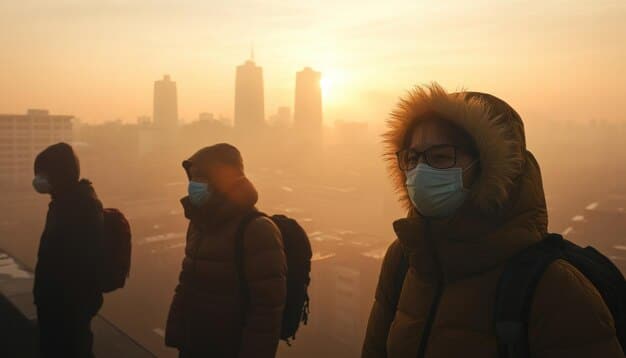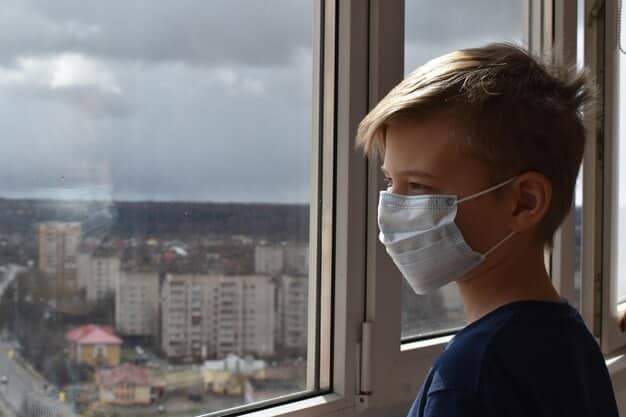Long-Term Health Impacts of Climate Change-Driven Air Pollution in the US

The long-term health impacts of increased air pollution due to climate change in the US include a rise in respiratory and cardiovascular diseases, exacerbated allergies, and mental health challenges, disproportionately affecting vulnerable populations.
Understanding what are the long-term health impacts of increased air pollution due to climate change in the US is crucial as our planet warms. This convergence of environmental crises presents a complex and evolving threat to public health, demanding our attention and informed discourse.
The Intertwined Crises: Climate Change and Air Pollution
The relationship between climate change and air pollution is far more intricate than often perceived. It’s a feedback loop where rising global temperatures don’t just exacerbate existing air quality issues; they actively create new pathways for pollutants to form and linger. This interaction poses a significant challenge to public health, especially in a geographically diverse nation like the US.
Climate change drives myriad meteorological shifts that directly influence how pollutants behave in our atmosphere. For instance, increased heatwaves lead to stagnant air masses, trapping pollutants closer to the ground. Wildfires, fueled by hotter, drier conditions, release vast quantities of fine particulate matter and toxic gases. Dust storms, more frequent in aridifying regions, contribute to airborne particulate matter. Each of these phenomena can dramatically alter local and regional air quality, often for prolonged periods.
Understanding the Feedback Loop
It’s not just a one-way street; air pollution itself can influence climate. Black carbon, a component of particulate matter, absorbs sunlight and contributes to warming. Methane, a potent greenhouse gas, is also a precursor to ground-level ozone, a harmful air pollutant. This complex relationship amplifies the challenges faced by health systems and environmental regulators.
- Heatwaves increase ground-level ozone formation, a respiratory irritant.
- Wildfires, intensified by drought and heat, emit fine particulate matter (PM2.5) that can travel thousands of miles.
- Changes in precipitation patterns can reduce the “wash-out” effect of pollutants, leading to their accumulation.
- Stronger storms can redistribute pollutants, affecting areas previously less impacted.
The atmospheric chemistry involved is also critical. Higher temperatures can accelerate chemical reactions in the atmosphere that form secondary pollutants, such as ground-level ozone. This “smog,” often associated with urban areas, becomes more pervasive under warmer conditions, extending its reach and impact. The implications for long-term respiratory health are profound, necessitating a deeper understanding of these interconnected processes.
Ultimately, addressing the health impacts of air pollution stemming from climate change requires a holistic approach. It’s not enough to tackle emissions in isolation; we must consider the broader climatic context that dictates their formation, transport, and ultimate impact on human populations. This integrated perspective is vital for developing effective mitigation and adaptation strategies.
Respiratory Health: A Breathless Future?
The human respiratory system, finely tuned to process clean air, bears a significant brunt of increased air pollution. From chronic conditions to acute episodes, the long-term health impacts are profound and varied, affecting individuals across all age groups but with disproportionate severity in vulnerable populations.
Fine particulate matter (PM2.5), a common component of air pollution from sources like fossil fuel combustion and wildfires, can penetrate deep into the lungs. Once there, these microscopic particles can cause inflammation, oxidative stress, and structural damage. Over time, this exposure contributes to a substantial increase in conditions such as asthma, chronic obstructive pulmonary disease (COPD), and bronchitis. For those already suffering from these ailments, increased pollution often means more frequent and severe exacerbations, leading to hospitalizations and reduced quality of life.
Asthma and Allergy Exacerbation
Climate change not only increases primary pollutants but also impacts aeroallergens. Warmer temperatures and increased CO2 levels can extend pollen seasons and boost pollen production, creating a double whammy for allergy sufferers. When combined with particulate matter, these allergens can lead to intensified allergic reactions and more severe asthma attacks.
- Particulate matter irritates airways, making them more susceptible to allergens.
- Increased ground-level ozone can trigger asthma symptoms and reduce lung function.
- Prolonged exposure to air pollutants can lead to permanent changes in lung tissue.
- Children and the elderly are particularly vulnerable to pollution-induced respiratory issues.

Furthermore, air pollution can compromise the immune system within the lungs, making individuals more susceptible to respiratory infections like influenza and pneumonia. In a world grappling with emerging infectious diseases, a weakened respiratory defense system carries additional risks. The consistent exposure to airborne toxins creates a state of chronic inflammation, making the lungs less efficient and more prone to disease.
The long-term effects also extend to lung development in children. Studies suggest that children growing up in highly polluted areas may experience reduced lung capacity and function, setting them up for respiratory problems throughout their lives. This generational impact underscores the urgency of addressing air quality degradation. The burden on public health systems, from emergency room visits to long-term care for chronic respiratory diseases, stands to increase significantly.
Cardiovascular Disease: The Silent Threat
Beyond the lungs, air pollution poses a formidable, often silent, threat to the cardiovascular system. The intricate pathways through which pollutants affect the heart and blood vessels are increasingly understood, revealing a pervasive impact that contributes to a range of serious conditions.
Exposure to fine particulate matter (PM2.5) has been consistently linked to an elevated risk of heart attacks, strokes, and arrhythmias. These tiny particles, once inhaled, can enter the bloodstream and trigger systemic inflammation. This inflammation can damage blood vessel linings, contribute to the formation and rupture of atherosclerotic plaques, and increase blood clotting, all of which are critical factors in the development of cardiovascular disease.
Mechanisms of Cardiovascular Harm
The impact isn’t limited to PM2.5. Other pollutants, like ground-level ozone and nitrogen oxides, also play a role. Ozone, a powerful oxidant, can affect the heart by causing oxidative stress and inflammation, leading to impaired vascular function. Nitrogen oxides, primarily from vehicle emissions, have been associated with increased blood pressure and other markers of cardiovascular strain.
- Systemic inflammation triggered by airborne particles.
- Endothelial dysfunction, impairing blood vessel relaxation and contributing to high blood pressure.
- Increased risk of atherosclerosis (hardening of the arteries).
- Elevated chances of heart attacks, strokes, and heart failure.
- Disruption of the heart’s electrical rhythms (arrhythmias).
Long-term exposure can lead to a gradual but cumulative damage to the cardiovascular system. Individuals living in areas with persistently high levels of air pollution often exhibit higher rates of hypertension, coronary artery disease, and heart failure. The insidious nature of this threat means that symptoms may not appear until significant damage has occurred, making prevention even more critical.
Furthermore, the interaction between pollution and existing cardiovascular conditions can be particularly dangerous. For those with pre-existing heart disease, even moderately elevated pollution levels can trigger acute events. The increased frequency of extreme heat events due to climate change can compound these risks, as heat stress on the body places additional strain on the cardiovascular system, especially in the presence of compromised air quality. Addressing air pollution is therefore not just a lung health issue, but a comprehensive cardiovascular health imperative.
Neurological and Mental Health Impacts
While the respiratory and cardiovascular links to air pollution are well-established, an emerging body of research is shedding light on its profound neurological and mental health impacts. The brain, once considered relatively protected, is now increasingly understood to be vulnerable to airborne toxins, with implications for cognitive function and psychological well-being.
Fine particulate matter, due to its minute size, can bypass the blood-brain barrier and directly enter the brain, or it can induce systemic inflammation that signals the brain. Once in the brain, these particles can cause neuroinflammation and oxidative stress, leading to neuronal damage and accelerating neurodegenerative processes. Studies have begun to link long-term exposure to air pollution with an increased risk of cognitive decline, dementia (including Alzheimer’s disease), and even Parkinson’s disease.
Climate Change Amplifying Mental Stressors
Beyond direct neurological harm, climate change-induced air pollution exacerbates mental health challenges through indirect pathways. The visible haze and compromised air quality can lead to feelings of helplessness, anxiety, and a reduced sense of well-being. Coupled with the broader anxieties surrounding climate change itself—such as eco-anxiety or solastalgia (a sense of melancholia or loss experienced when one’s home environment is changing)—the cumulative psychological burden can be substantial.
- Increased risk of depression and anxiety disorders.
- Cognitive impairment and reduced academic performance in children.
- Accelerated cognitive decline and dementia risk in older adults.
- Stress from environmental degradation can worsen existing mental health conditions.
- Sleep disturbances due to poor air quality can further impact mental well-being.
Children are particularly susceptible to these neurodevelopmental effects. Emerging evidence suggests that exposure to air pollution during critical windows of brain development can impact cognitive abilities, attention spans, and even contribute to behavioral issues. The implications for educational outcomes and long-term societal productivity are significant. The urban environment, often a hotspot for both traditional pollutants and climate-driven air quality issues, becomes a critical area of concern for these neurodevelopmental impacts.
Furthermore, the indirect psychological effects of living in a compromised environment cannot be underestimated. Constant awareness of poor air quality can reduce outdoor physical activity, which is itself a protective factor against many mental health conditions. The psychological distress caused by the inability to recreate outdoors or by the visible evidence of environmental decay contributes to the overall burden on mental health. Addressing air pollution is therefore also a vital component of fostering societal mental well-being.
Vulnerable Populations: Disproportionate Burden
While air pollution affects everyone, its long-term health impacts are not distributed equally across the US population. Climate change, by exacerbating air quality issues, amplifies existing health disparities, placing a disproportionate burden on already vulnerable communities. Understanding these vulnerabilities is crucial for equitable public health interventions.
Children are especially susceptible due to their developing organ systems, higher breathing rates relative to their body size, and greater time spent outdoors. Exposure to air pollutants during critical developmental windows can lead to lifelong health issues, including reduced lung function, increased asthma severity, and neurodevelopmental delays. Their immature immune systems are less equipped to handle the inflammatory responses triggered by pollutants.
Socioeconomic and Racial Disparities
Historically, low-income communities and communities of color have been disproportionately located near industrial facilities, major roadways, and other sources of pollution. This environmental injustice means these groups often experience higher baseline levels of chronic pollutant exposure. When climate change brings novel or intensified air pollution events, such as prolonged heatwaves causing ozone spikes or increased wildfire smoke, these communities are hit harder.
- Low-income communities often lack access to quality healthcare and air purifiers.
- Outdoor workers, many from minority groups, face higher occupational exposure risks.
- Pre-existing health conditions are often more prevalent in marginalized communities.
- Limited political power can hinder effective advocacy for local clean air initiatives.

The elderly, particularly those with pre-existing cardiovascular or respiratory conditions, also face heightened risks. Their diminishing physiological reserves make them less resilient to the stress imposed by air pollution. Heatwaves combined with high ozone or PM2.5 levels can overwhelm their systems, leading to increased rates of hospitalizations and mortality. Many older adults live on fixed incomes, limiting their ability to afford protective measures like air conditioning or air filtration systems.
Furthermore, indigenous communities, often located in rural or remote areas, face unique vulnerabilities. Climate change impacts like wildfires and dust storms, which are increasing in severity and frequency, directly affect their air quality. Their reliance on traditional practices and natural resources also makes them highly dependent on healthy ecosystems, which are themselves compromised by environmental degradation. Tailored interventions and community-led solutions are essential to address these profound and persistent disparities.
Economic and Social Costs of Worsening Air Quality
Beyond the direct health impacts, the long-term deterioration of air quality due to climate change levies substantial economic and social costs across the United States. These costs ripple through healthcare systems, productivity, education, and community well-being, creating a multifaceted burden that affects every sector of society.
Healthcare expenditures represent a significant portion of these costs. Increased rates of chronic respiratory diseases, cardiovascular conditions, and neurological disorders necessitate more doctor visits, prescriptions, hospitalizations, and specialized long-term care. These direct medical expenses strain public and private insurance systems, ultimately impacting taxpayers and individuals through higher premiums and out-of-pocket costs. The economic toll of asthma attacks alone, from emergency room visits to missed school or work days, runs into billions annually.
Productivity Losses and Reduced Quality of Life
A sicker workforce is a less productive workforce. Increased illness leads to more absenteeism, reduced on-the-job efficiency, and premature mortality, all of which translate into lost economic output. For sectors heavily reliant on outdoor labor, such as agriculture or construction, periods of severe air pollution can halt work entirely, leading to wage losses for workers and decreased revenue for businesses.
- Increased healthcare costs for chronic and acute conditions.
- Lost productivity due to illness and premature mortality.
- Reduced agricultural output from crop damage caused by ozone.
- Lower property values in heavily polluted areas.
- Tourism decline in regions affected by persistent haze or smoke.
The social fabric of communities also suffers. Poor air quality can lead to reduced outdoor recreational activities, impacting mental well-being and social cohesion. Parents may choose to keep children indoors, affecting their physical activity and development. Schools might face closures or reduced outdoor time, affecting educational outcomes. The aesthetic impact of haze and smog on landscapes can also deter tourism, affecting local economies reliant on natural beauty.
Moreover, the cost of adaptation and mitigation measures, such as developing early warning systems for air quality, investing in air filtration for public buildings, or implementing new regulatory frameworks, also contribute to the economic burden. While these investments are necessary to protect public health, they represent resources diverted from other productive uses. The economic argument, therefore, strongly supports aggressive action to mitigate climate change and improve air quality, as the costs of inaction are proving to be far greater.
Future Projections and Mitigation Strategies
Looking ahead, future projections suggest that without significant and sustained mitigation efforts, the long-term health impacts of increased air pollution due to climate change in the US will continue to escalate. Understanding these projections and identifying viable mitigation strategies are critical steps toward protecting public health.
Scientific models consistently forecast a rise in both the frequency and intensity of extreme weather events, which are direct drivers of air pollution. This includes more prolonged heatwaves leading to higher ground-level ozone concentrations, more severe and frequent wildfires releasing vast amounts of particulate matter, and altered precipitation patterns affecting pollutant dispersion. The combined effect means that even if traditional industrial emissions decline, new and amplified sources of air pollution tied to climate change will emerge, posing continuous public health challenges.
Adaptive Approaches and Policy Needs
Addressing these future challenges requires a multi-pronged approach that integrates climate action with public health policy. Mitigation strategies must focus on reducing greenhouse gas emissions that drive climate change, which will, in turn, reduce many of the climate-related air pollution sources. This means transitioning to renewable energy, improving energy efficiency, and promoting sustainable transportation actively.
- Transitioning to clean energy sources reduces emissions that form ozone and PM2.5.
- Improving building efficiency lowers energy demand and associated air pollution.
- Enhancing public transportation and electric vehicle adoption reduces urban pollution.
- Investing in wildfire prevention and management strategies limits smoke exposure.
- Developing robust urban planning that considers air quality and green spaces.
Beyond broad mitigation, adaptive strategies are also essential. This includes developing advanced air quality monitoring systems to provide real-time data, establishing early warning systems for pollution events, and implementing public health advisories to protect vulnerable populations. Investing in clean air infrastructure, such as filtration systems in schools and hospitals, becomes increasingly important. Public education campaigns can also empower individuals to take personal protective measures during high-pollution days.
Policy frameworks need to be robust and forward-looking, integrating climate and air quality regulations. This includes tightening emission standards, promoting sustainable land use practices that reduce fire risk and dust, and investing in research to better understand the evolving nexus between climate, air quality, and health. The scientific understanding is clear: proactive and integrated action is the only path to safeguard long-term public health amidst a changing climate and its associated air quality challenges.
Addressing Health Inequities Through Integrated Policy
Effectively addressing the long-term health impacts of increased air pollution due to climate change in the US cannot be achieved without confronting the profound health inequities that define our society. An integrated policy approach must explicitly prioritize the protection and empowerment of vulnerable populations who disproportionately bear the brunt of environmental degradation.
Current policies often treat climate change, air pollution, and health disparities as separate issues. However, their interconnectedness demands a synergistic response. For example, emission reduction strategies, while beneficial overall, may not sufficiently alleviate the burden in communities located near specific point sources or highly trafficked areas. True equity requires targeted interventions that consider the unique vulnerabilities and existing pollution burdens of frontline communities. This might involve stricter local emission controls, investment in green infrastructure, and community-led air monitoring programs.
Community Engagement and Resource Allocation
Central to an equitable approach is meaningful community engagement. Policies need to be co-created with the very populations they aim to serve. This ensures that solutions are culturally appropriate, address felt needs, and harness local knowledge and resilience. Empowering communities through participatory research and decision-making processes can lead to more effective and sustainable outcomes, transitioning away from top-down directives.
- Prioritize air quality improvements in historically burdened communities.
- Invest in green infrastructure, such as urban forests, to improve local air quality.
- Ensure equitable access to clean air technologies, like home air purifiers.
- Fund community health initiatives focused on pollution-related illnesses.
- Support job creation in the green economy for vulnerable populations.
Furthermore, resource allocation must reflect these priorities. Funding for public health programs, particularly those focused on respiratory and cardiovascular health in at-risk communities, needs to be bolstered. This includes accessible and affordable healthcare, preventative screenings, and educational resources on how to cope with poor air quality events. Investments in clean energy and sustainable transportation solutions located within or near these communities can also provide both health benefits and economic opportunities.
Beyond direct health interventions, policies supporting affordable housing, access to healthy food, and reliable public transportation indirectly contribute to better health outcomes by reducing overall stress and improving access to resources. When health inequities stemming from centuries of systemic injustice are acknowledged and actively addressed within climate and air quality policies, the long-term health of the entire nation stands to improve meaningfully. It’s a moral and practical imperative to ensure that the benefits of clean air and a stable climate are shared by all.
| Key Impact | Brief Description |
|---|---|
| 💨 Respiratory Diseases | Increased rates of asthma, COPD, and lung damage from fine particulate matter and ozone pollution. |
| ❤️ Cardiovascular Issues | Higher risk of heart attacks, strokes, and arrhythmias due to systemic inflammation. |
| 🧠 Neuro/Mental Health | Cognitive decline, dementia risk, and increased anxiety/depression linked to pollution exposure. |
| 👥 Disproportionate Burden | Vulnerable populations (children, elderly, low-income, minorities) face amplified health risks. |
Frequently Asked Questions
▼
Climate change intensifies air pollution in several ways. Warmer temperatures accelerate the formation of ground-level ozone. Increased droughts and heat fuel more severe wildfires, releasing vast amounts of particulate matter. Stagnant air masses under heat domes can trap pollutants, preventing their dispersion and leading to higher concentrations near the ground.
▼
Long-term exposure to increased air pollution significantly impacts respiratory and cardiovascular systems. This includes exacerbated asthma and COPD, increased risk of heart attacks, strokes, and arrhythmias. Emerging evidence also links it to cognitive decline, dementia, and mental health issues like anxiety and depression.
▼
Yes, children, the elderly, individuals with pre-existing chronic conditions, and low-income communities or communities of color are particularly vulnerable. Children’s developing lungs and higher breathing rates make them susceptible, while the elderly have diminished physiological reserves. Socioeconomically disadvantaged communities often bear a higher pollution burden due to historical injustices.
▼
The economic costs are substantial. They include increased healthcare expenditures from treating pollution-related illnesses, lost productivity due to illness and premature mortality, and reduced agricultural output. There can also be indirect costs like decreased tourism in affected areas and a general reduction in community well-being and outdoor activities.
▼
Mitigation requires a dual approach: aggressively reducing greenhouse gas emissions to slow climate change, and directly addressing air pollution sources. This involves transitioning to clean energy, improving energy efficiency, promoting sustainable transportation, and implementing strong air quality regulations. Adaptive strategies like improved air quality monitoring and warnings are also vital.
Conclusion
The intricate dance between climate change and air pollution presents a daunting, yet undeniable, threat to the long-term health of populations across the United States. From the strained breaths of those with chronic respiratory conditions to the subtle neurological impacts and the pervasive weight on mental well-being, the consequences are far-reaching and disproportionately borne by the most vulnerable among us. Addressing this complex challenge demands an integrated, equitable approach—one that prioritizes comprehensive climate action, robust air quality regulations, and targeted health interventions. The future health of the nation hinges on our collective ability to understand these profound connections and to act decisively to safeguard the air we breathe.





